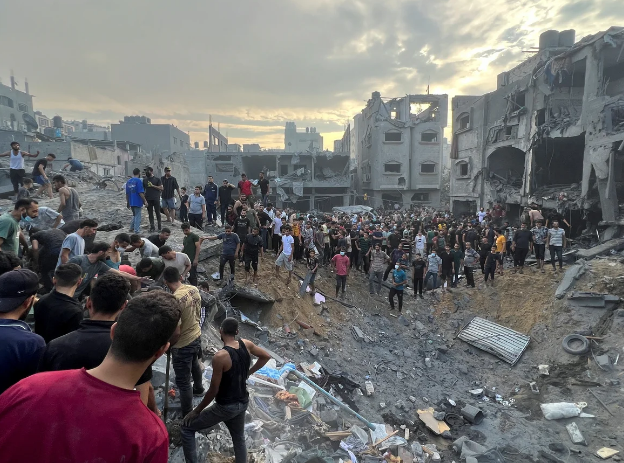On a quiet evening in Barja, Lebanon, Ahmad Abou Bahiri was relaxing at home when an Israeli airstrike suddenly struck the nearby building. Just 40 minutes south of Beirut, his life changed in an instant. Moments after he was smoking shisha, he found himself desperately searching through the rubble for his wife and children, who were sleeping in the next room.
As he sifted through the debris, he found a leg. Initially, he feared it belonged to his wife, but soon realized it was from the four-story building next door, which was the target of the bombing. Tragically, at least 35 people died in the attack, including children, with the civil defense team finding body parts of four individuals in Mr. Abou Bahiri’s bedroom.
“There were pieces of human flesh everywhere. Our neighbor was thrown from this house; you can see the trace of blood on the ceiling,” he said, pointing to a dark red stripe overhead.
Miraculously, Mr. Abou Bahiri’s family sustained only minor injuries despite their home being destroyed. “It’s a miracle,” he remarked, still shaken by the horror of the event.
Barja is a predominantly Sunni town in the Chouf district of Mount Lebanon, located on a hill overlooking the Mediterranean. Since the Israeli airstrikes began last month, Barja had only been hit once before and is far from the southern regions of Lebanon where the Israeli army has been actively engaged in combat against Hezbollah.
The Israeli military has targeted many areas in Lebanon’s Shiite heartlands, viewed as Hezbollah’s strongholds, but the recent strikes indicate a broader reach.
Like many of Israel’s attacks, there was no warning for civilians before the bombing in Barja. This incident adds to the grim toll of over 3,000 people killed in Lebanon since Hezbollah and Israel began exchanging fire in October, most casualties occurring since Israel’s large-scale air campaign and ground invasion started on September 23.
Mr. Abou Bahiri was on his sofa when the strike hit his neighbor’s home. He described how body parts flew into his home, covering him and his family.
When visited Barja about 14 hours after the strike, rescuers were still digging through the wreckage. They were not searching for survivors but for more body parts, as the stench of burnt flesh filled the air. Children’s toys, Pokémon cards, drawing boards, and clothes were scattered across the area. One rescuer discarded make-up and pencils while searching, while another sprayed the site with water to help clear the mess, as local families watched from their balconies.
Moustafa Danaj, a Civil Defence member, mentioned recovering the body of a five-year-old girl who had been decapitated in the bombing. “We pulled out many children,” he noted, while staff at the Siblin Governmental Hospital reported receiving the bodies of at least two children.
A home for displaced families stood where the strike occurred. The building had been rented to Shia families fleeing the Israeli bombings in the south. Residents noted that they hadn’t seen anything unusual since the families arrived a month earlier.
The building’s residents included the Basma, Faqih, and Hajij families, who were related. According to announcements from the municipality of Ain Baal, a town where the Basma family is from, 16 family members died in the strike, most of whom were women and children, including a nine-year-old girl named Lynn. Her passport photo was found among the documents scattered across Mr. Abou Bahiri’s apartment, tossed there by the force of the explosion.
The Israeli military claims its strikes target Hezbollah members and their weapons, but they have not clarified their target in Barja. This isn’t the first time an Israeli attack has led to high civilian casualties in areas believed to be safe; several recent strikes remain unexplained, leading to rampant speculation.
Some local news reports, lacking evidence, claimed a Hezbollah member lived in the targeted building, a claim that could not independently verify. The group has not commented on these allegations.
The Amal Movement, an ally of Hezbollah involved in ceasefire negotiations with the US, released memorial photos of three “martyrs” from the Basma family, including a woman and two men in civilian clothing.
These images contrast with photos of Amal’s armed wing fighters who have died, who are shown in military uniforms with ranks noted. This distinction indicates that the family was politically affiliated but did not have military roles.
Mr. Abou Bahiri reported that Lebanese army intelligence had taken devices belonging to the displaced families at the site to investigate.
“We saw nothing wrong; they were just ordinary families. I’m not involved in politics, and I don’t care about religion. We welcomed them with all our humanity,” Mr. Abou Bahiri said.
“We didn’t expect this, so now we’re scared of newcomers in the area,” said Rayan, a neighbor who requested her last name not be used.
Bilal Abdullah, a local MP representing the Progressive Socialist Party, noted an increase in attacks on Mount Lebanon, a non-Shiite area without ties to Hezbollah. This has raised fears that they might unknowingly host displaced Shia families with connections to the group.
However, Mr. Abdullah stressed that Lebanese people will not allow Israel to create sectarian conflict, recalling the country’s painful 15-year civil war that split communities along sectarian lines. “We stand united,” he declared.
“Even if we have political differences, we will remain united. We will not let Israel ignite another civil war in Lebanon,” he added.
Mr. Abdullah suggested that Israel seems to target anyone associated with Hezbollah, even on suspicion alone, which justifies their violent actions without proof.
He acknowledged that some displaced individuals may have ties to Hezbollah, but insists that this doesn’t change the fact that innocent women, children, and the elderly were killed in the attacks.





